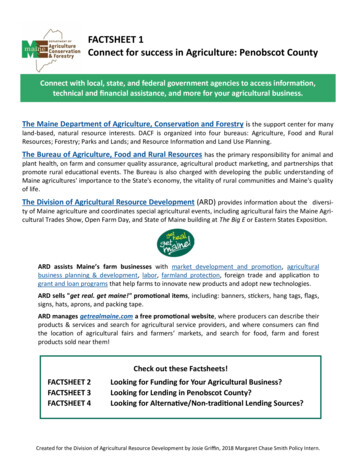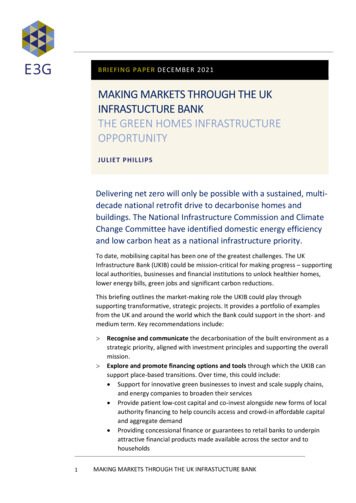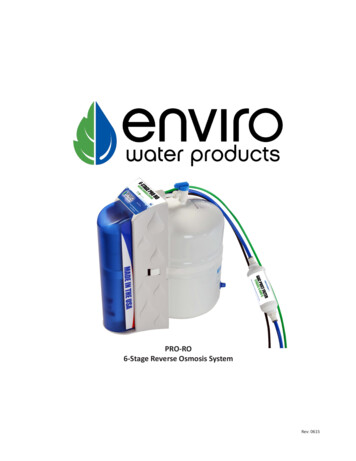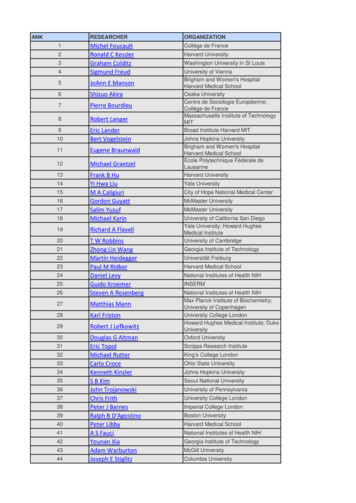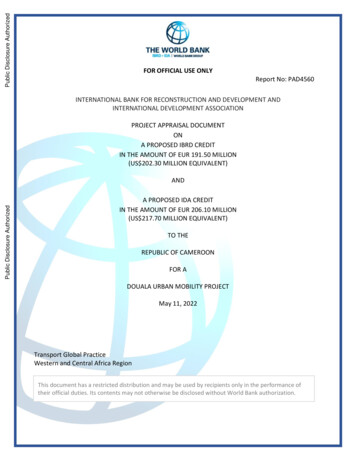
Transcription
Public Disclosure AuthorizedFOR OFFICIAL USE ONLYReport No: PAD4560Public Disclosure AuthorizedPublic Disclosure AuthorizedINTERNATIONAL BANK FOR RECONSTRUCTION AND DEVELOPMENT ANDINTERNATIONAL DEVELOPMENT ASSOCIATIONPROJECT APPRAISAL DOCUMENTONA PROPOSED IBRD CREDITIN THE AMOUNT OF EUR 191.50 MILLION(US 202.30 MILLION EQUIVALENT)ANDA PROPOSED IDA CREDITIN THE AMOUNT OF EUR 206.10 MILLION(US 217.70 MILLION EQUIVALENT)TO THEREPUBLIC OF CAMEROONFOR ADOUALA URBAN MOBILITY PROJECTPublic Disclosure AuthorizedMay 11, 2022Transport Global PracticeWestern and Central Africa RegionThis document has a restricted distribution and may be used by recipients only in the performance oftheir official duties. Its contents may not otherwise be disclosed without World Bank authorization.
CURRENCY EQUIVALENTS(Exchange Rate Effective April 30, 2022)Currency Unit CFA Franc (XAF)EuroCFA 621 US 1.00Euro 0.94652 US 1.00FISCAL YEARJanuary 1 - December 31Regional Vice President: Ousmane DiaganaCountry Director: Abdoulaye SeckRegional Director: Ashish KhannaPractice Manager: Ibou DioufTask Team Leaders: Franck Taillandier, Anastasia Touati
ABBREVIATIONS AND utomatic Fare Collection SystemAgence Française de Développement (French Development Agency)Assistance à Maitrise d’Ouvrage (Project Management Firm)Annual Work Plan and BudgetBus Rapid TransitCaisse Autonome d’Amortissement (Autonomous Sinking Funds)Conseil d'Appui à la Réalisation des Contrats de Partenariat (Support Council forthe Implementation of Partnership Contracts)Central Business DistrictCertificat de Conformité Environnementale (Certificate of EnvironmentalCompliance)Corridor Development StrategyCommunauté Economique et Monétaire de l’Afrique Centrale (Central AfricanEconomic and Monetary Community)Contingent Emergency Response ComponentCarbon MonoxideCarbon DioxideCoronavirus Disease 2019Country Partnership FrameworkCountry Policy and Institution AssessmentCountry Partnership FrameworkCity Resilience ProgramCivil Society OrganizationCommunauté Urbaine de Douala (Douala City Council)Designated AccountDisbursement and Financial Information LetterEnvironmental and SocialEconomic Internal Rate of ReturnEnquêtes Ménages Déplacements (Household Travel Surveys)Environmental and Social Impact AssessmentEnvironmental and Social Management FrameworkEnvironmental and Social Management PlanEnvironmental and Social Standards AdvisorFragility, Conflict and ViolenceFinancial ManagementGender-Based ViolenceGross Domestic ProductGross National IncomeGreenhouse GasGross National IncomeGovernment of CameroonGreen, Resilient, and Inclusive DevelopmentGrievance Redress MechanismInternational Bank for Reconstruction and Development
RAInternational Development AssociationInternally Displaced PeopleInternational Finance CorporationInterim Financial ReportInvestment Project FinancingIntelligent Transport SystemsJobs and Economic TransformationMonitoring and EvaluationMultilateral Investment Guarantee AgencyMinistère de l’Economie, du Plan et de l’Aménagement du Territoire (Ministry ofEconomy, Planning, and Regional Development)Ministère de l'Environnement, de la Protection de la Nature et DéveloppementDurable (Ministry of Environment, Nature Protection and SustainableDevelopment)Ministère des Finances (Ministry of Finance)Ministère de l’Habitat et du Développement Urbain (Ministry of Housing andUrban Development)Ministère des Marchés Publics (Ministry of Public Procurement)Ministère des Transports (Ministry of Transport)Ministère des Travaux Publics (Ministry of Public Works)Notre Dame Global Adaptation InitiativeNationally Determined ContributionNon-Governmental OrganizationNon-motorized TransportNitrogen OxidesNew Procurement FrameworkNet Present ValueOccupational Health and SafetyProject Affected PersonPrivate Capital MobilizationProject Development ObjectivePlan Directeur d’Urbanisme (Urban Master Plan)Plan de Déplacement Urbain et des Transports (Urban Transport Plan)Projet de Développement des Villes Inclusives et Résilientes (Cameroon Inclusiveand Resilient Cities Development Project)Per Hour in the Peak DirectionProject Implementation ManualProject Implementation UnitParticulate MatterPlan de Mobilité Urbaine Soutenable (Sustainable Urban Mobility Plan)Project Steering CommitteeProcurement PlanProject Preparation AdvancePublic-Private PartnershipProject Procurement Strategy for DevelopmentPrevention and Resilience Allocation
SAUNDPUNFCCCUNHCRUS VOCWBWBGXAFResettlement Action PlanResettlement Policy FrameworkSustainable Development GoalsSexual Exploitation and Abuse/Sexual HarassmentStakeholder Engagement PlanStratégie Nationale de Développement (National Development Strategy)Société Camerounaise de Transports Urbains (Privately Owned Bus Compnay)Shadow Price of CarbonSexually Transmitted DiseaseSystematic Tracking of Exchanges in ProcurementTechnical AssistanceTransit-Oriented DevelopmentTerms of ReferenceUnited Nations Department of Economic and Social AffairsUnited Nations Development ProgrammeUnited Nations Framework Convention on Climate ChangeUnited Nations High Commissioner for RefugeesUnited States DollarVehicle Operating CostsWorld BankWorld Bank GroupCFA Franc (CFA)
The World BankDouala Urban Mobility Project (P167795)TABLE OF CONTENTSDATASHEET . Error! Bookmark not defined.I.STRATEGIC CONTEXT . 8A. Country Context. 8B. Sectoral and Institutional Context . 11C. Relevance to Higher Level Objectives. 18II.PROJECT DESCRIPTION. 21A. Project Development Objective (PDO) . 21B. Project Components . 22C. Project Cost and Financing . 29D. Project Beneficiaries . 30E. Results Chain . 31F. Rationale for World Bank Involvement and Role of Partners . 31G. Lessons Learned and Reflected in the Project Design. 32III. IMPLEMENTATION ARRANGEMENTS . 33A. Institutional and Implementation Arrangements . 33B. Results Monitoring and Evaluation Arrangements. 35C. Sustainability. 35IV. PROJECT APPRAISAL SUMMARY . 35A. Technical, Economic and Financial Analysis . 35B. Fiduciary. 41C. Safeguards . 43V. KEY RISKS . 48VI. RESULTS FRAMEWORK AND MONITORING . 52ANNEX 1: Implementation Arrangements and Support Plan . 68ANNEX 2: Activities to Enhance Climate Change Resilience and Reduce GHG Emissions ofUrban Transport in Douala . 80ANNEX 3: Measuring the Impact of the Restructuring of Douala’s Public TransportNetwork on Accessibility within the City . 84ANNEX 4: TOD Approach Adopted and Selection Principles for the Pilot Sites Investments. 89
The World BankDouala Urban Mobility Project (P167795)DATASHEETBASIC INFORMATIONBASIC INFO TABLECountry(ies)Project NameCameroonDouala Urban Mobility ProjectProject IDFinancing InstrumentEnvironmental Assessment CategoryP167795Investment ProjectFinancingA-Full AssessmentFinancing & Implementation Modalities[ ] Multiphase Programmatic Approach (MPA)[ ] Contingent Emergency Response Component (CERC)[ ] Series of Projects (SOP)[ ] Fragile State(s)[ ] Performance-Based Conditions (PBCs)[ ] Small State(s)[ ] Financial Intermediaries (FI)[ ] Fragile within a non-fragile Country[ ] Project-Based Guarantee[ ] Conflict[ ] Deferred Drawdown[ ] Responding to Natural or Man-made Disaster[ ] Alternate Procurement Arrangements (APA)[ ] Hands-on Enhanced Implementation Support (HEIS)Expected Approval DateExpected Closing Date02-Jun-202216-Jun-2028Bank/IFC CollaborationJoint LevelYesComplementary or Interdependent project requiring active coordinationProposed Development Objective(s)The Project Development Objective is to improve urban mobility and support inclusive urban and economicdevelopment along selected Bus Rapid Transit corridors and its feeder lines in Douala.Page 1 of 92
The World BankDouala Urban Mobility Project (P167795)ComponentsComponent NameCost (US , millions)Support to institutional strengthening and professionalization of existing publictransport operators11.00BRT infrastructure facilities, systems, and rolling stock470.00Transit-oriented development around the BRT system42.00Project management and capacity building17.00Contingent Emergency Response0.00OrganizationsBorrower:Republic of CameroonImplementing Agency:Communaute Urbaine de Douala (Douala City Council)PROJECT FINANCING DATA (US , Millions)SUMMARY-NewFin1Total Project Cost540.00Total Financing540.00of which IBRD/IDAFinancing GapDETAILS420.000.00-NewFinEnh1World Bank Group FinancingInternational Bank for Reconstruction and Development (IBRD)202.30International Development Association (IDA)217.70IDA Credit217.70Non-World Bank Group FinancingCounterpart Funding20.00Page 2 of 92
The World BankDouala Urban Mobility Project (P167795)20.00Local Govts. (Prov., District, City) of Borrowing CountryCommercial Financing100.00100.00Unguaranteed Commercial FinancingIDA Resources (in US , Millions)Credit AmountCameroonNational PBATotalGrant AmountGuarantee AmountTotal 700.000.00217.70INSTITUTIONAL DATAPractice Area (Lead)Contributing Practice AreasTransportUrban, Resilience and LandClimate Change and Disaster ScreeningThis operation has been screened for short and long-term climate change and disaster risksSYSTEMATIC OPERATIONS RISK-RATING TOOL (SORT)Risk CategoryRating1. Political and Governance High2. Macroeconomic Substantial3. Sector Strategies and Policies Moderate4. Technical Design of Project or Program Substantial5. Institutional Capacity for Implementation and Sustainability Substantial6. Fiduciary Substantial7. Environment and Social Substantial8. Stakeholders HighPage 3 of 92
The World BankDouala Urban Mobility Project (P167795)9. Other Substantial10. Overall HighCOMPLIANCEPolicyDoes the project depart from the CPF in content or in other significant respects?[ ] Yes[ ] NoDoes the project require any waivers of Bank policies?[ ] Yes[ ] NoSafeguard Policies Triggered by the ProjectYesEnvironmental Assessment OP/BP 4.01 Performance Standards for Private Sector Activities OP/BP 4.03 Natural Habitats OP/BP 4.04 NoForests OP/BP 4.36 Pest Management OP 4.09 Physical Cultural Resources OP/BP 4.11 Indigenous Peoples OP/BP 4.10Involuntary Resettlement OP/BP 4.12 Safety of Dams OP/BP 4.37 Projects on International Waterways OP/BP 7.50 Projects in Disputed Areas OP/BP 7.60 Legal CovenantsSections and DescriptionSection I.A.1 (a) of Schedule 2 of the LA/FA and in the PA: The Borrower/Recipient shall establish by no later thanone (1) month after the Effective Date, and thereafter maintain at all times during the implementation of theProject, a Project Steering Committee with terms of reference, composition, powers, functions, staffing, facilitiesand other resources satisfactory to the Bank/Association, to be responsible for inter alia, overseeing overall Projectperformance, approving Annual Work Plans and Budgets, providing strategic oversight and guidance, andsupporting the mobilization of counterpart funds for the Project.Page 4 of 92
The World BankDouala Urban Mobility Project (P167795)Sections and DescriptionSection I.A.2 (d) (i) of Schedule 2 of the LA/FA and in the PA : Without limitation to the provisions of paragraph (a),(b), and (c) above, the Borrower/Recipient shall cause the Project Implementing Entity to no later than three (3)months after Effective Date, recruit and appoint: (1) the monitoring and evaluation specialist, (2) thecommunication officer, (3) the social and environmental supervisor, (4) the RAP expert, (5) the GBV and genderspecialist, (6) the Health, Safety and Environment (HSE) expert, and (7) the assistant to the procurement specialist;Sections and DescriptionSection I.A.2 (d) (ii) of Schedule 2 of the LA/FA and in the PA: Without limitation to the provisions of paragraph (a),(b), and (c) above, the Borrower/Recipient shall cause the Project Implementing Entity to not later than six (6)months after the Effective Date, recruit, and thereafter retain, an external auditor with qualification and experiencesatisfactory to the Bank/Association.Sections and DescriptionSection I.A.3 of Schedule 2 of the LA/FA and in the PA: The Borrower/Recipient shall not later than one (1) monthafter Effective Date, establish and operationalize a special tender board for the Project in line with the Borrower’sprocurement regulations, to be responsible for overseeing the review of procurement documentation related tothe Project in a manner acceptable to the Bank. Without limitation to the foregoing, until such time that the specialtender board referred to in this paragraph shall have been established and become operational, theBorrower/Recipient shall vest the functions of the special board onto the Project Implementing Entity’s internaltender board, all in a manner satisfactory to the Bank/Association.Sections and DescriptionSection I.B.1 (b) of Schedule 2 of the LA/FA and in the PA: The Borrower/Recipient, through the ProjectImplementing Entity, shall, by no later than two (2) months after the Effective Date prepare and adopt a Projectprocedures manual, containing detailed guidelines and procedures for administrative, financial management, anddisbursement, and other fiduciary matters under the Project, in form and substance acceptable to theBank/Association (the “Project Procedures Manual”).Sections and DescriptionSection I.B.2 (b) of Schedule 2 of the LA/FA and in the PA : the Borrower/Recipient shall cause the ProjectImplementing Entity to not later than November 30 of each year, furnish the draft annual work plan and budget forthe following year to the Bank/Association for its review, and promptly thereafter finalize the draft annual workplan and budget, taking into account the Bank or Association’s comments thereon; provided, that for the first yearof Project implementation, the Borrower/Recipient shall furnish the draft annual work plan and budget by no laterthan one (1) month after the Effective Date.Sections and DescriptionSection I.C.1 of Schedule 2 of the LA/FA: For purpose of carrying out Part 1of the Project the Borrower shall causethe Project Implementing Entity to enter into, not later than six (6) months after the Effective Date, and thereaftermaintain throughout the period of Project implementation, a service agreement with CODATU, under terms andconditions approved by the Bank/Association (the “Service Agreement”), whereby the Borrower shall: (a) hire theservices of CODATU to implement the above referred Component activities in accordance with the provisions of thePIM.Page 5 of 92
The World BankDouala Urban Mobility Project (P167795)Sections and DescriptionSection IV.A of Schedule 2 of the FA/LA and in the PA: To facilitate the implementation of Part 2 (c) of the Project,and prior to rolling stock acquisition, the Borrower/Recipient shall cause the Project Implementing Entity to take allnecessary steps to put in place and maintain an overall legal, financial and institutional framework acceptable tothe Bank/Association for the operational performance and maintenance of the BRT, and to this end shall, withoutlimitation to the foregoing, unless otherwise agreed with the Bank/Association, enter into a contract (PPPAgreement) in a manner satisfactory to the Bank/Association, no later than twelve (12) months after the EffectiveDate (or such later date acceptable to the Bank/Association), with an operator with qualifications and experienceacceptable to the Bank/Association (the “Private Operator”) on terms and conditions satisfactory to theBank/Association, selected through a transparent international competitive bidding process, which shall include,inter alia, the obligation of the Private Operator to acquire, operate and maintain a BRT bus fleet in accordancewith the terms of the PPP Agreement.Sections and DescriptionSection I.F(a) of Schedule 2 of the LA/FA and in the PA: The Borrower shall cause the Project Implementing Entity toadopt, not later than three (3) months after the Effective Date, the Stakeholder Engagement Plan in form andsubstance satisfactory to the Bank/Association; (ii) thereafter, carry out, and cause the Project Implementing Entityto carry out, the Stakeholder Engagement Plan with due diligence and efficiency and communicate the StakeholderEngagement Plan to the Project stakeholders: (A) to achieve their participation and support of the Project all alongthe period of Project implementation; and (B) to ensure its measures and recommendations are implementedthroughout Project implementation, in particular with a focus on the security of women, children and othervulnerable groups, taking the necessary measures to help prevent and, as necessary, respond appropriately to therisks and incidences of sexual exploitation and abuse and sexual harassment against women, children and othervulnerable groups. Except as Bank/Association shall otherwise agree, the Borrower shall ensure, and cause theProject Implementing Entity to ensure, that the Stakeholder Engagement Plan is not amended, suspended orwaived. In case of any inconsistencies between the provisions of the Stakeholder Engagement Plan and theprovisions of this Agreement, the provisions of this Agreement shall prevail.ConditionsTypeEffectivenessFinancing sourceIBRD/IDADescriptionLA/FA; Article V, Section 5.01(a): The Subsidiary Agreement has beenexecuted on behalf of the Borrower/Recipient and the ProjectImplementing Entity in accordance with the provisions of Section I.Dof Schedule 2 to this Agreement.TypeEffectivenessFinancing sourceIBRD/IDADescriptionLA/FA; Article V, Section 5.01(b): The Project Implementing Entityhas adopted the Project Implementation Manual in accordance withthe provisions of Section I.B of Schedule 2 to this Agreement andSection I.B.2 of the Schedule 1 to the Project Agreement.Page 6 of 92
The World BankDouala Urban Mobility Project (P167795)TypeEffectivenessFinancing sourceIBRD/IDADescriptionLA/FA; Article V, Section 5.01(c): The Borrower/Recipient, throughthe Project Implementing Entity shall have established the CUD-PIU,with functions and a composition satisfactory to the Association,through the recruitment and appointment of a Project coordinator, afinancial management specialist, a procurement specialist, anaccountant, an internal auditor, an environmental specialist, a socialspecialist, an infrastructure and urban development specialist, all ofthem under terms of reference and with qualifications andexperience satisfactory to the Bank/Association;TypeEffectivenessFinancing sourceIBRD/IDADescriptionLoan Agreement; Article V, Section 5.01(d): The FinancingAgreement has been executed and delivered and all conditionsprecedent to the effectiveness of said agreements (other than theexecution and effectiveness of this Agreement) have been fulfilled.TypeEffectivenessFinancing sourceIBRD/IDADescriptionFinancing Agreement; Article V, Section 5.01(d): The LoanAgreement has been executed and delivered and all conditionsprecedent to the effectiveness of said agreements (other than theexecution and effectiveness of this Agreement) have been fulfilled.Page 7 of 92
The World BankDouala Urban Mobility Project (P167795)I. STRATEGIC CONTEXTA. Country Context1. A lower-middle-income country located in Sub-Saharan Africa, Cameroon has experienced an economicdownturn since 2016 but can capitalize on several opportunities to foster economic growth. The country spreadsover 475,000 square kilometers (km), with 600 km of coast along the Atlantic Ocean in the Gulf of Guinea. It sharesborders with six countries1, of which two, Chad and the Central African Republic are landlocked. With a GrossDomestic Product (GDP) of US 39.1 billion in 2019 and Gross National Income (GNI) per capita of US 3,730 in2019, Cameroon is the largest economy of the Central African Economic and Monetary Community (CommunautéEconomique et Monétaire de l’Afrique Centrale, CEMAC), producing 45 percent of the community’s nominal GDPin 2020. Despite a decrease in its economic growth rate from 5.6 percent in 2015 to 3.7 percent in 2019 due toslower growth in oil production, and the shock of the Coronavirus disease (COVID-19) pandemic resulting in thedeceleration of GDP growth to 0.5 percent in 2020, the country can capitalize on its position as a key regionaltransport hub, but also on its rapidly developing urban economies, which hold great potential.2.The fast-paced population growth in Cameroon has allowed for a notable urbanization rate that stands outamong its Sub-Saharan peers. Cameroon is home to almost 26.5 million inhabitants, with a population growth of2.6 percent per year over the last decade.2 The country has one of the highest rates of urbanization in the SubSaharan region, with 58 percent of its population living in urban areas, compared to 41 percent in Sub-SaharanAfrica.3 As urban population growth is expected to continue at an annual rate of 4 percent, large urban centerslike Douala and Yaoundé are set to grow at a steady pace in the coming decades. United Nations Department ofEconomic and Social Affairs (UNDESA) estimates that 70 percent of Cameroonians will live in urban areas by 2050.4This accelerated pace of urbanization offers significant opportunities for the country, as cities in Cameroon are atleast 1.8 times more productive than rural areas.5 However, this trend places increased demand on thegovernment and cities to deliver urban services, as limited access to decent housing, jobs, electricity, poorsanitation, and lack of clean water are leading to increased vulnerability.3.High centralization and inefficient governance have led the economy to perform far below its potential.Inadequate service delivery, limited transparency, and accountability, a fragmented bureaucracy, and inertia indecision-making limit the scope for economic growth and poverty reduction. Cameroon experiences high levelsof corruption, with the country ranking 149th out of 180 countries in the 2020 Transparency Internationalcorruption perceptions index.6 In addition, economic growth is hampered by the complexity of tax, customs, andregulatory enforcement and excessive state involvement in most major tradeable industries. Based on the CountryPolicy and Institution Assessment (CPIA) Business Regulatory Environment rating, which assesses the extent towhich a country’s legal, regulatory, and policy environment help or hinder private businesses in investing, creatingjobs, and becoming more productive, Cameroon ranked 14th out of 38 among its African peers in 2018.74.Cameroon is a country affected by Fragility, Violence and Conflict (FCV) situations classified at the mediumintensity conflict level. The country is still afflicted by internal and regional violence and its sociopolitical outlook1Nigeria, Chad, Central African Republic, Republic of Congo, Gabon, and Equatorial Guinea.World Bank Population data for 2020.3 World Bank data, 2020.4 United Nations Urbanization prospects, 2018.5 Cameroon City Competitiveness Diagnostic, World Bank, 2018.6 Transparency International, Corruption perceptions index 2020: https://www.transparency.org/en/cpi/2020/index/7 CPIA Africa: Assessing Africa’s Policies and Institutions, World Bank, August 2020.2Page 8 of 92
The World BankDouala Urban Mobility Project (P167795)remains critical. The ongoing conflicts in some parts of Cameroon and in neighboring countries have exacerbatedpressures on urban centers. Although the political situation has seen improvements following 2008’s violent riotcrisis (Émeutes de la Faim), the looming presence of and attacks perpetrated by terrorist groups (notably BokoHaram) near the northern and northeastern borders with Nigeria and Chad continue to destabilize the countryand region. In the southwestern and northwestern regions, a secessionist insurgency has been raging over thepast four years and displaced more than 700,000 people towards municipalities in the neighboring regions,including the Littoral region which hosts over 80,000 Internally Displaced People (IDP).8 IDP are in all regionsalthough the majority is concentrated in the northwestern and southwestern, Littoral and West regions.Cameroon is also a haven for around 480,000 refugees and just under 7,000 asylum seekers from neighboringconflict-afflicted countries, mostly from Nigeria and the Central African Republic. Close to 8,000 refugees and4,000 asylum seekers are settled in Douala alone.95.Levels of poverty in Cameroon remain high, with the COVID-19 pandemic threatening to reverse much of themodest progress in poverty reduction achieved in recent years. At the national level, 24 percent of the populationis living in extreme poverty, with less than US 1.90 per day,10 suggesting that the good economic performanceover the recent years (4.6 percent GDP increase in 2014-2019) has not translated into a substantial povertyreduction. According to World Bank estimates, the pandemic has wiped out recent modest gains in povertyreduction, with poverty incidence reverting to its 2015 level, while the absolute number of poor has continued toincrease. Indeed, for the first time in more than a decade, it is estimated that the international poverty rateincreased by 0.82 percentage points between 2019 and 2020 due to COVID-19. Although poverty in Cameroonremains a mostly rural phenomenon, poverty incidence in urban areas has nearly doubled between 2014 and2018, from 9 percent to 17 percent, and economic disparities between regions have continued to widen. Thenorthern regions have traditionally been the poorest and have had lower access to basic social services. Progressin poverty reduction has been slow due to different poverty trends across regions, with significant deteriorationin welfare levels in the northwestern and southwestern regions. The conflict in these regions is increasing internaldisplacement, putting pressure on jobs, and increasing vulnerability.6.The impacts of poverty are exacerbated by high rates of inequalities. Income distribution in Cameroon is highlyunequal, as reflected by a Gini ratio of 0.47. According to the United Nations (UN), 13 percent of the nationalincome is shared by the poorest 40 percent, while 35 percent of the same income is shared by the richest 10percent.11 These economic disparities are heightened by significant gender inequalities. Women and girls (50percent of the population in 2016) are more likely than men and boys to live in poverty in part due to the lack ofeducation, and to the customs of early marriage. In Cameroon, 31.7 percent of adult women have reached at leasta secondary level of education compared to 37.9 percent of their male counterparts, while female participationin the labor market is 71.0 percent compared to 81.1 for men. Adolescent marriage remains common, with 35percent of girls married before the age of 18.7.There are clear gender gaps in employment in Cameroon. Women’s labor force participation is relatively high inCameroon, with corresponding levels of education, however, the structure of employment differs significantlywhen compared to that of men, as women are mainly employed in the agriculture sector while men are als
FOR OFFICIAL USE ONLY Report No: PAD4560 INTERNATIONAL ANK FOR RE ONSTRUTION AND DEVELOPMENT AND INTERNATIONAL DEVELOPMENT ASSOIATION Public Disclosure Authorized

